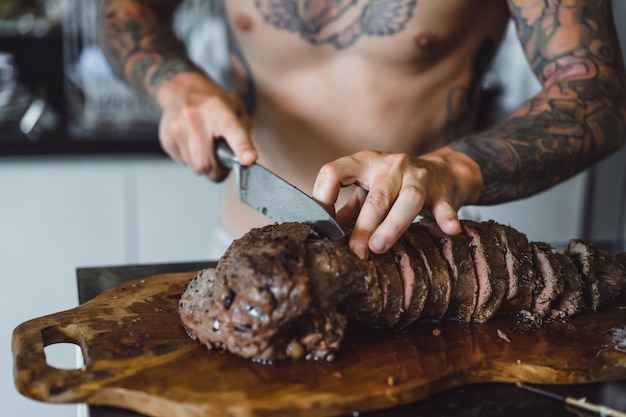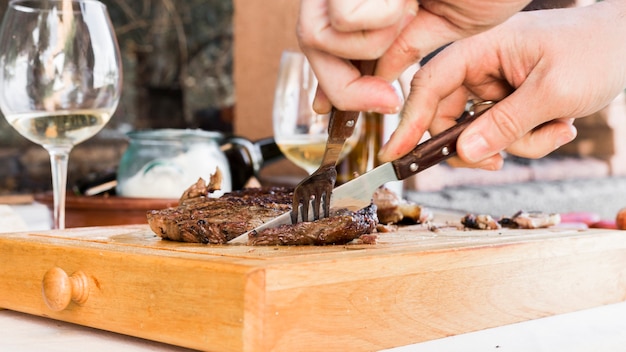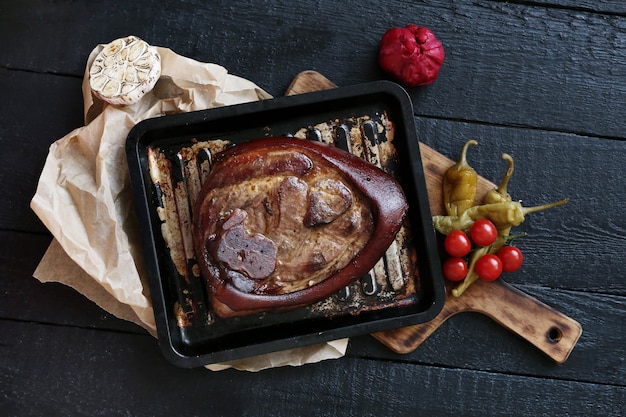Ah, ribeye. The king of steaks, the ultimate indulgence. Just the thought of that buttery, marbled meat, sizzling on the pan, makes my mouth water. But getting a ribeye perfectly cooked, that's where the real magic happens. You want that perfect balance of juicy, tender, and perfectly cooked, not raw, not dry. You want that delicious sear on the outside, and that pink, melt-in-your-mouth centre.
I've been through my fair share of steak disasters, believe me. Overcooked, dry, tough... the works. But over time, I've learned a few tricks of the trade. I've experimented with different methods, different temperatures, and different timings. I've even taken a few cooking classes (don't judge!). And let me tell you, it's all about knowing your steak.
This guide is your ultimate resource for mastering the art of cooking ribeye steak. We'll delve into everything from choosing the right cut to achieving your desired doneness, and we'll even throw in a few tips for making your steak truly spectacular. So grab a glass of something nice, get ready to dive in, and let's get cooking!
(Part 1) Understanding Doneness: It's All About Temperature

Before we even start talking about cooking time, we need to get on the same page about what we're aiming for. Doneness levels are measured by internal temperature, and each has its own unique texture and look. Here's a breakdown to help you understand what you're looking for:
Rare: A Little Red For the Bold
Let's be honest, rare steak is not for everyone. It's still red throughout, with a cool, almost raw texture. The temperature hovers between 125°F (52°C) and 130°F (54°C). It's ideal for those who appreciate a more intense, almost gamey flavour. If you're not used to it, it can be a bit shocking, but it's definitely a flavour explosion.
Medium-Rare: The Classic Choice
This is the sweet spot for many, and for good reason. It's got a little bit of pink in the centre, but it's firm enough to cut cleanly. The temperature sits between 130°F (54°C) and 135°F (57°C). It's a balanced, satisfying experience, where the tenderness of the meat meets the perfect level of cooked flavour.
Medium: A Step Closer to Well-Done
For those who prefer a bit more cooking, medium is where it's at. The inside is a pale pink, with a slight browning around the edges. The temperature ranges from 135°F (57°C) to 140°F (60°C). It's a step closer to well-done, but still juicy and tender, not dry and tough.
Medium-Well: A Safe Bet
This is where the pink starts to fade, replaced by a light brown. The centre is still slightly pink, but it's no longer the star of the show. The temperature sits between 140°F (60°C) and 150°F (65°C). It's a good option if you're unsure about rare or medium, a safe middle ground for those who don't want too much pink.
Well-Done: Thoroughly Cooked for Some
Well-done is for those who like their steak thoroughly cooked. There's no pink left, just a uniform brown throughout. The temperature is above 150°F (65°C). It's dry, firm, and has a distinct chew. Personally, I'd rather have a perfectly cooked medium-rare, but hey, to each their own!
(Part 2) choosing the right ribeye: The Foundation of a Great Steak

You can't have a great steak without a great piece of meat. Choosing the right ribeye is crucial, and it's an investment worth making. Here's what to look for:
Marbling: The Key to Juiciness
This is the key to a flavourful and juicy steak. Marbling refers to the intramuscular fat that runs through the meat. The more marbling, the richer and juicier the steak will be. Aim for a ribeye with good marbling, not too much and not too little. You want that lovely balance of fat and lean meat.
Thickness: Just Right for Even Cooking
The thickness of your ribeye will affect cooking time and evenness. A thicker cut will take longer to cook and may need a different approach than a thinner one. Aim for a steak that's at least 1 inch thick, but not exceeding 2 inches. It's a good balance for consistent cooking, ensuring you get that delicious sear on the outside while keeping the inside juicy and tender.
Colour: A Sign of Freshness
A fresh ribeye should have a bright red colour, almost a deep crimson hue. Avoid any steaks that are brown or discoloured, as this could indicate spoilage. Also, check for any unpleasant odours.
(Part 3) The Right Tools for the Job: Essential Equipment for Success

You've got the perfect ribeye, now you need the right tools. These are my essentials, and they're worth the investment for anyone who loves a good steak:
- cast iron skillet: A classic for searing steaks. It gets incredibly hot and distributes heat evenly. Plus, the seasoned cast iron adds a touch of extra flavour to the steak.
- meat thermometer: An absolute must-have for accurately checking internal temperature. No more guessing!
- Tongs: For safely flipping and moving your steak. Use tongs, not a fork, to avoid piercing the steak and losing precious juices.
- Cutting board: For prepping your steak and serving it on. Choose a sturdy board that can withstand the heat and weight of the steak.
- Sharp knife: To slice your steak beautifully. A good chef's knife is essential for slicing against the grain, resulting in tender, juicy pieces.
(Part 4) Prepping Your Ribeye for Success: Getting Ready for the Heat
Don't underestimate the power of a little pre-cooking prep. It might seem like a small detail, but it makes a big difference in the final result.
Pat Dry: The Key to a Crispy Sear
A wet ribeye won't get that perfect sear. Pat it dry with paper towels to remove excess moisture. This will ensure that the heat of the pan concentrates on the surface of the steak, creating a beautiful, crispy crust.
Seasoning: Simple is Often Best
Salt is your best friend. Season liberally with kosher salt and freshly ground black pepper. You can also add other spices like garlic powder, onion powder, or paprika, but remember, sometimes less is more. Let the natural flavour of the ribeye shine through.
Room Temperature: For Even Cooking
This is important! Let your ribeye come to room temperature before cooking. It allows for more even cooking and prevents cold spots. Think of it like preheating the oven for your steak.
(Part 5) The Searing Technique: Achieving that Delicious Crust
This is the crucial step for achieving that delicious crust that elevates a good steak to something truly special. Here's how to do it right:
High Heat: Let the Pan Scream
Get your cast iron skillet screaming hot. You want to hear that sizzle when you put the steak in. If the pan isn't hot enough, the steak will steam instead of sear.
Sear on Both Sides: Creating a Flavor Barrier
Place your steak in the skillet and let it sear for 2-3 minutes per side. Don't move it around too much, let it get a nice crust. The sear acts like a protective barrier, locking in the juices and developing that incredible flavour.
Sear the Sides: Full-Circle Deliciousness
Once both sides are seared, sear the edges for 30-60 seconds to create a beautiful crust all around. This step might seem small, but it makes a big difference in the overall flavour and presentation.
(Part 6) Finishing the Cook: Bringing Your Steak to Perfection
You've got the sear, now it's time to finish cooking your ribeye and reach your desired doneness. There are two main methods, each with its own advantages.
oven method: Consistent and Reliable
This is my go-to method for consistency and even cooking. Transfer your seared ribeye to a preheated oven at 375°F (190°C). Use the following cooking times as a guide, but always check the internal temperature with a meat thermometer for accuracy:
| Doneness | Cooking Time |
|---|---|
| Rare | 5-7 minutes |
| Medium-Rare | 7-9 minutes |
| Medium | 9-11 minutes |
| Medium-Well | 11-13 minutes |
| Well-Done | 13-15 minutes |
Remember, these are just guidelines. Cooking times can vary depending on the thickness of your steak and the temperature of your oven. Always check the internal temperature with a meat thermometer to ensure it's cooked to your liking.
Stovetop Method: Quick and Easy
For a quicker cook, you can finish on the stovetop. Reduce the heat to medium-low and continue cooking, flipping every minute or two. This method requires more attention to ensure even cooking, but it can be a good option for a quick weeknight meal.
(Part 7) The Resting Ritual: The Key to Juicy, tender steak
Don't be tempted to dive in right away! Resting your ribeye is crucial for tenderizing and retaining those delicious juices. It's like giving the steak a chance to relax and recover from the heat.
Rest for 5-10 Minutes: Let the Juices Redistribute
Place your cooked ribeye on a cutting board and loosely cover it with foil. This allows the juices to redistribute throughout the steak, resulting in a much more tender and juicy result.
(Part 8) The Slice and Serve: Presenting Your Culinary Masterpiece
After resting, you're ready to slice and serve. Use a sharp knife to slice against the grain, which will create tender, juicy pieces. Think about the direction the muscle fibres run in the steak and slice perpendicular to them.
Garnish and Presentation: A Touch of Elegance
Don't forget the finishing touches! A simple garnish of fresh herbs, a drizzle of olive oil, or a pinch of sea salt can elevate your ribeye to new heights. A few sprigs of rosemary or thyme add a touch of colour and aroma.
(Part 9) Beyond the Basics: Taking Your Steak Game to the Next Level
Here are a few extra tricks to take your ribeye game to the next level and impress even the most discerning steak lover:
reverse searing: For Ultimate Juiciness and Tenderness
For an exceptionally juicy and tender steak, try reverse searing. This method involves cooking the steak slowly in the oven until it reaches almost the desired doneness, then searing it in a hot pan for a crust. It's a bit more time-consuming but worth it for the results. You'll get a perfectly cooked centre and a delicious crispy exterior.
Herb-Butter Rub: A Burst of Flavor
Elevate the flavour with a herb-butter rub. Simply mix softened butter with your favourite herbs, like rosemary, thyme, or oregano. Spread it generously on your steak before searing. The butter will melt and infuse the steak with a delicious, fragrant flavour.
steak sauce: A Touch of Enhancement
While a good steak doesn't need much, a touch of steak sauce can enhance the flavour. Opt for a high-quality sauce with a balanced flavour profile. Avoid those overly sweet or sugary sauces, and look for something that complements the natural flavour of the steak.
FAQs: Common Questions and Answers
1. Can I use a grill to cook ribeye steak?
Absolutely! Grilling is a fantastic way to cook ribeye. Just make sure your grill is preheated to medium-high heat and sear the steak for 2-3 minutes per side. Use a meat thermometer to check the internal temperature for your desired doneness.
2. How do I know if my steak is cooked to my desired doneness?
The best way is to use a meat thermometer. Insert it into the thickest part of the steak and make sure it doesn't touch bone. The temperature should be consistent with the doneness you're aiming for.
3. Can I cook ribeye steak in a pan on the stovetop?
Yes, you can! Just make sure the pan is hot and sear the steak for 2-3 minutes per side. You may need to adjust the cooking time based on the thickness of your steak.
4. What are some good side dishes for ribeye steak?
There are so many delicious options! Some classic pairings include mashed potatoes, asparagus, creamed spinach, and roasted vegetables.
5. What should I do with leftover ribeye steak?
Leftover ribeye makes a fantastic sandwich! Slice the steak thin and serve it on toasted bread with your favourite toppings, like cheese, onions, and aioli.
There you have it! Your comprehensive guide to cooking the perfect ribeye steak. It's all about understanding the doneness, selecting the right cut, and following a few key steps. So next time you're craving a juicy, flavorful steak, remember this guide and get ready to impress!
Everyone is watching

Prime Rib Roast Cooking Time Chart: Per Pound Guide
Cooking TipsPrime rib roast. Just the name conjures images of lavish dinners, crackling fires, and hearty laughter. It’s ...

How Long to Bake Potatoes in the Oven (Perfect Every Time)
Cooking TipsBaked potatoes are a staple in my kitchen. They're incredibly versatile, delicious, and surprisingly easy to m...

Perfect Rice Every Time: The Ultimate Guide to Cooking Rice
Cooking TipsAs a self-proclaimed foodie, I've always been a bit obsessed with rice. It's the foundation of countless cuisi...

The Ultimate Guide to Cooking Asparagus: Tips, Techniques, and Recipes
Cooking TipsAsparagus. The mere mention of this spring delicacy conjures up images of vibrant green spears, crisp and burs...

Ultimate Guide to Cooking the Perfect Thanksgiving Turkey
Cooking TipsThanksgiving. Just the word conjures up images of overflowing tables laden with delicious food, the scent of r...
